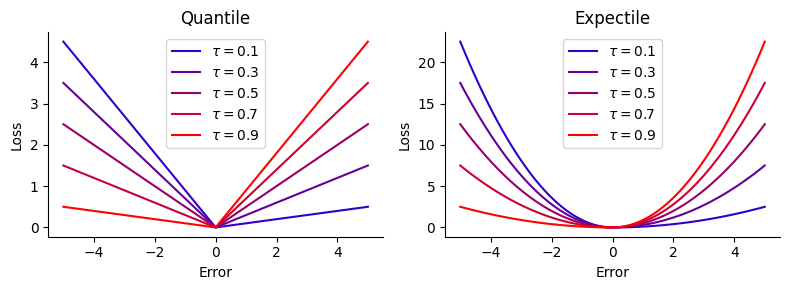分位点回帰とエクスペクタイル回帰
Contents
分位点回帰とエクスペクタイル回帰#
分位点回帰 (Quantile Regression)#
線形回帰(linear regression)は,誤差が正規分布と仮定したとき(必ずしも正規分布を仮定しなくてもよい)の\(X\)(説明変数)に対する\(Y\)(目的変数)の期待値\(E[Y]\)を求める,というものであった.分位点回帰(quantile regression) では,Xに対するYの分布における分位点を通るような直線を引く.
分位点(または分位数)において,代表的なものが四分位数である.四分位数は箱ひげ図などで用いるが,例えば第一四分位数は分布を25:75に分ける数,第二四分位数(中央値)は分布を50:50に分ける数である.同様に\(q\)分位数(\(q\)-quantile)というと分布を\(q:1-q\)に分ける数となっている.分位点回帰の話に戻る.下図は\(x\sim U(0, 5),\quad y=3x+x\cdot \xi,\quad \xi\sim N(0,1)\)とした500個の点に対する分位点回帰である.赤い領域はX=1,2,3,4でのYの分布を示している.深緑,緑,黄色の直線はそれぞれ10, 50, 90%tile回帰の結果である.例えば50%tile回帰の結果は,Xが与えられたときのYの中央値(50%tile点)を通るような直線となっている.同様に90%tile回帰の結果は90%tile点を通るような直線となっている.
using PyPlot, LinearAlgebra, Random
rc("axes.spines", top=false, right=false)
function QuantileGradientDescent(X, y, initθ, τ; lr=1e-4, num_iters=10000)
θ = initθ
for i in 1:num_iters
ŷ = X * θ # predictions
δ = y - ŷ # error
grad = abs.(τ .- 1.0(δ .<= 0.)) .* sign.(δ) # gradient
θ += lr * X' * grad # Update
end
return θ
end;
function gaussian_func(x, μ, σ)
return 0.8/σ*exp(-(x -μ)^2/(2σ^2))
end;
# Generate Toy datas
N = 500 # sample size
x = sort(5.5rand(N))
y = 3x + x .* randn(N);
X = ones(N, 2) # design matrix
X[:, 2] = x;
τs = [0.1, 0.5, 0.9]
m = length(τs)
Ŷ = zeros(m, N); # memory array
for i in 1:m
initθ = zeros(2) # init variables
θ = QuantileGradientDescent(X, y, initθ, τs[i])
Ŷ[i, :] = X * θ
end
# Results plot
figure(figsize=(5,4))
title("Quantile Regression")
for loc in 1:5
ξy = 0:1e-3:6loc
ξx = loc .+ gaussian_func.(ξy, 3loc, 1.2loc)
fill_between(ξx, -1, ξy, color="tab:red", linewidth=2, alpha=0.5)
plot(ξx, ξy, color="tab:red", linewidth=2)
end
cmvir = get_cmap(:viridis)
for i in 1:m
plot(x, Ŷ[i, :], linewidth=2, label=string(Int(τs[i]*100))*"%tile", color=cmvir(i/m)) # regression line
end
scatter(x, y, color="gray", s=5) # samples
xlabel("x"); ylabel("y")
xlim(0, 5.5); ylim(0, 25); legend()
tight_layout()

分位点回帰の利点としては,外れ値に対して堅牢(ロバスト)である,Yの分布が非対称である場合にも適応できる,などがある (Das et al., Nat Methods. 2019).
エクスペクタイル回帰 (Expectile regression)#
エクスペクタイル(expectile)は(Newey and Powell 1987) によって導入された統計汎関数 (statistical functional; SF)の一種であり,期待値(expectation)と分位数(quantile)を合わせた概念である.簡単に言えば,中央値(median)の一般化が分位数(quantile)であるのと同様に,期待値(expectation)の一般化がエクスペクタイル(expectile)である.
勾配法を用いた分位点回帰・エクスペクタイル回帰#
予測誤差\(\delta\)と\(\tau\)の関数を
と定義する.\(\rho_q(\delta; \tau)\)のみ,チェック関数 (check function)あるいは非対称絶対損失関数(asymmetric absolute loss function)と呼ぶ.ただし,\(\tau\)は分位点(quantile),\(\mathbb{I}\)は指示関数(indicator function)である.この場合,\(\mathbb{I}_{\delta \leq 0}\)は\(\delta \gt 0\)なら0, \(\delta \leq 0\)なら1となる.このとき,目的関数は
である.\(\rho(\delta; \tau)\)を色々な \(\tau\)についてplotすると次図のようになる.
δ = -5:0.1:5
τ= 0.1:0.2:0.9
cmbrg = get_cmap(:brg)
figure(figsize=(8,3))
subplot(1,2,1)
title("Quantile")
for i in 1:length(τ)
indic = 1.0(δ .<= 0)
z = (τ[i] .- indic) .* δ
plot(δ, z, color=cmbrg(0.5i/length(τ)), label=L"$\tau=$"*string(τ[i]))
end
xlabel("Error"); ylabel("Loss")
legend(); tight_layout()
subplot(1,2,2)
title("Expectile")
for i in 1:length(τ)
indic = 1.0(δ .<= 0)
z = abs.(τ[i] .- indic) .* δ.^2
plot(δ, z, color=cmbrg(0.5i/length(τ)), label=L"$\tau=$"*string(τ[i]))
end
xlabel("Error"); ylabel("Loss")
legend(); tight_layout()

分位点の場合,\(\rho_q(\delta; \tau)\)がチェックマーク✓に類似していることからこのような名前が付いている.
\(L_\tau\)を最小化するような\(\theta\)の更新式について考える.まず,
である (ただし\(\text{sign}(\cdot)\)は符号関数).さらに
が成り立つので,\(\theta\)の更新式は\(\theta \leftarrow \theta + \alpha\cdot \dfrac{1}{n} \rho^{\prime}(\delta; \tau) X\)と書ける (\(\alpha\)は学習率である).分位点回帰を単純な勾配法で求める場合,勾配が0となって解が求まらない可能性があるが,目的関数を滑らかにすることで回避できるという研究もある (Zheng. IJMLC. 2011).この点,Expectileならこの問題を回避できる (?).
function QuantileGradientDescent(X, y, initθ, τ; lr=0.1, num_iters=10000)
θ = initθ
for i in 1:num_iters
ŷ = X * θ # predictions
δ = y - ŷ # error
grad = abs.(τ .- 1.0(δ .<= 0.)) .* sign.(δ) # gradient
θ += lr * X' * grad # Update
end
return θ
end
function ExpectileGradientDescent(X, y, initθ, τ; lr=0.1, num_iters=10000)
θ = initθ
for i in 1:num_iters
ŷ = X * θ # predictions
δ = y - ŷ # error
grad = 2*abs.(τ .- 1.0(δ .<= 0.)) .* δ # gradient
θ += lr * X' * grad # Update
end
return θ
end;
# Generate Toy datas
num_train, num_test = 100, 500 # sample size
dims = 4 # dimensions
Random.seed!(0);
x = rand(num_train) #range(0.1, 0.9, length=num_train)
y = sin.(2π*x) + 0.3randn(num_train);
X = hcat([x .^ p for p in 0:dims-1]...); # design matrix
xtest = range(0, 1, length=num_test)
Xtest =hcat([xtest .^ p for p in 0:dims-1]...);
τs = [0.01, 0.1, 0.5, 0.9, 0.99]
m = length(τs)
# Quantile regression
initθ = zeros(dims)
Ŷq = zeros(m, num_test); # memory array
for i in 1:m
θq = QuantileGradientDescent(X, y, initθ, τs[i], lr=1e-2, num_iters=1e5)
Ŷq[i, :] = Xtest * θq
end
# Expectile regression
initθ = zeros(dims)
Ŷe = zeros(m, num_test); # memory array
for i in 1:m
θe = ExpectileGradientDescent(X, y, initθ, τs[i], lr=1e-2, num_iters=1e5)
Ŷe[i, :] = Xtest * θe
end
normal_equation(Xtest, X, y) = Xtest * ((X' * X) \ X' * y)
normal_equation (generic function with 1 method)
ŷ = normal_equation(Xtest, X, y); # predictions
# Results plot
figure(figsize=(15,5), dpi=100)
subplot(1,3,1)
title("Quantile Regression")
cm = get_cmap(:viridis)
for i in 1:m
plot(xtest, Ŷq[i, :], linewidth=2, label=string(Int(τs[i]*100))*"%tile", color=cm(i/m)) # regression line
end
plot(xtest, ŷ, color="tab:red", "--", label="Ordinary reg.") # regression line
scatter(x, y, color="gray", s=10) # samples
xlabel("x"); ylabel("y"); legend(ncol=2)
# Results plot
subplot(1,3,2)
title("Expectile Regression")
cm = get_cmap(:viridis)
for i in 1:m
plot(xtest, Ŷe[i, :], linewidth=2, label=string(Int(τs[i]*100))*"%tile", color=cm(i/m)) # regression line
end
plot(xtest, ŷ, color="tab:red", "--", label="Ordinary reg.") # regression line
scatter(x, y, color="gray", s=10) # samples
xlabel("x"); legend(ncol=2)
subplot(1,3,3)
title("Quantile & Expectile Regression")
fill_between(xtest, Ŷq[1, :], Ŷq[end, :], alpha=0.5, label="Quantile reg.")
fill_between(xtest, Ŷe[1, :], Ŷe[end, :], alpha=0.5, label="Expectile reg.")
scatter(x, y, color="gray", s=10) # samples
xlabel("x"); legend()
tight_layout()

参考文献#
Das, K., Krzywinski, M. & Altman, N. Quantile regression. Nat Methods 16, 451–452 (2019) doi:10.1038/s41592-019-0406-y
Quantile and Expectile Regressions (pdf)

